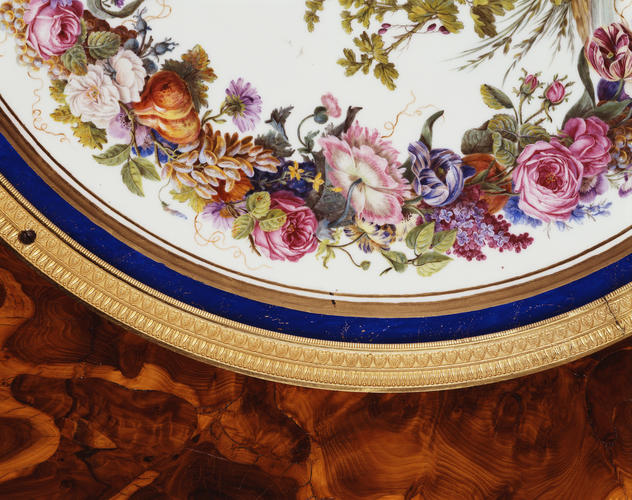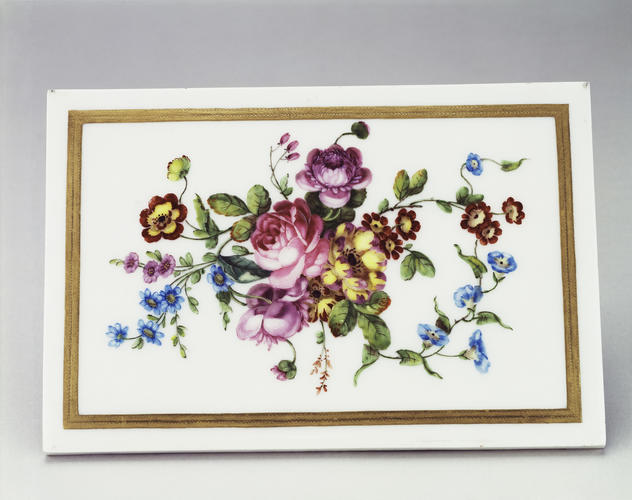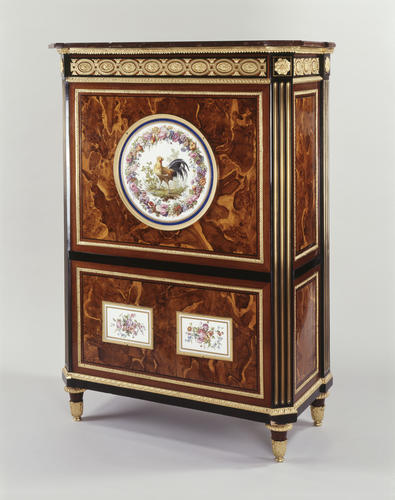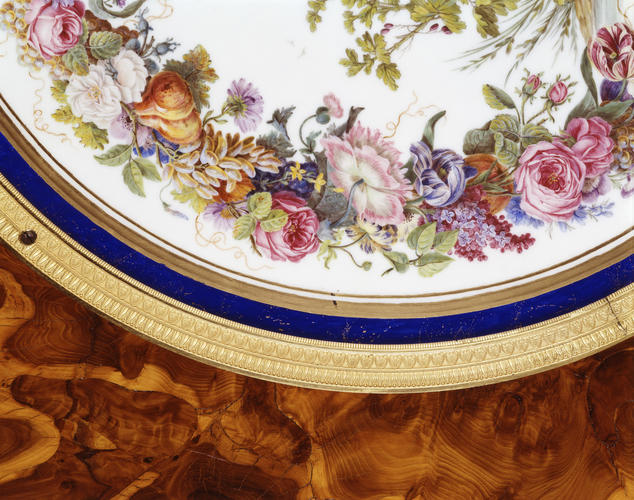-
1 of 253523 objects
Secrétaire late 18th century
Oak veneered in ebony, yew, kingwood and mahogany with porcelain and gilt bronze mounts and marble top. | 152.4 x 107.3 x 51.0 cm (Secretaire) (whole object) | RCIN 20308

Sèvres porcelain factory
Secrétaire late 18th century

Sèvres porcelain factory
Secrétaire late 18th century




-
An upright rectangular secretaire, of oak and pine veneered with ebony (?burr yew wood), purplewood, rosewood and mahogany. The mounts are of bronze chased and gilt, and the porcelain plaques are of soft-paste Sèvres porcelain. The slab, which has a moulded fore-edge, is of red griotte marble. The secretaire has brass-fluted uprights, the front ones canted, and slightly recessed rectangular panels of yew wood on the front and ends, which are edged with ebony ribbons, banded with purplewood and bordered with mouldings chased with foliage. It is supported on four peg-top feet shod in acanthus-leaf cups and fitted with gadroon-and-leaf capitals, all in gilt bronze. It contains a frieze drawer and, below the drop-front, a door which opens to reveal two drawers above a space closed by a hinged flap. The nest behind the drop-front is fitted with sixteen drawers, with below a pigeon-hole and above a shelf. Originally this cabinet would not have been fitted with porcelain plaques, and would have had two drawers beneath the drop-front. The interior fittings are modern (1935-6) and at some point since 1805, the original white marble top has been replaced by the existing red one. Shortly after its purchase by George IV, it passed through the hands of Vulliamy, who restored it and regilded its mounts at a cost of £64 1s. Seventeen years later, having been earmarked for use in The Boudoir at Windsor Castle, it was given the same treatment by Morel & Seddon for an unspecified sum. The circular plaque by Sèvres was received by Micaud for decoration on 27 January 1792. He painted the flowers and passed it to the bird painter Philippe Castel (active 1772-97), who painted the cockerel, probably after a design by Pieter Boel (1622-74). It was fired in the kiln on 19 December 1792. The plaque subsequently appeared in a lottery at the château de Saint Cloud. It was not amongst the winning numbers though, as it reappears among the items sold for cash to a M. Woodford on 2 April 1802. On this evidence, the circular plaque and probably also the rectangular ones together with their gilt bronze frames, whose distinctive chasing would suggest that they date from the period of the Directoire or later, must have been added to the secretaire between 2 April 1802 and 20 March 1805. Adapted from 'French Porcelain in the Collection of Her Majesty The Queen', by Sir Geoffrey de Bellaigue, London 2009. Vol. III, pp.1008-1011.
Provenance
Bought at auction at Henry Phillips (Sale No. 473) on 20 March 1805 by The Prince of Wales: ‘A Magnificent Cabinet formed of Yew tree with Porcelain Medallion of a Pheasant [sic] and flowers in front and rich Or Molu mountings £189’. Part of the group of furniture and furnishings restored between 1827 and 1829 to King George IV by the partnership of Morel and Seddon for The Boudoir at Windsor Castle. Nicholas Morel had formerly worked for The Prince of Wales, later George IV, at Carlton House and the Royal Pavilion at Brighton. Subsequently, he was commissioned to design and furnish the newly built apartments designed by Sir Jeffry Wyattville (1766-1840) for the King at Windsor Castle. In order to fulfil the contract he entered into partnership with George Seddon III whose family had large and long established furniture workshops in Aldersgate Street in the City of London.
-
Creator(s)
(porcelain manufacturer)(nationality)(porcelain painter)(restorer)Acquirer(s)
-
Medium and techniques
Oak veneered in ebony, yew, kingwood and mahogany with porcelain and gilt bronze mounts and marble top.
Measurements
152.4 x 107.3 x 51.0 cm (Secretaire) (whole object)
41.6 cm (Width) x 0.6 cm (Depth) (Round plaque) (diameter)
21.2 x 14.5 x 0.7 cm (Rectangular plaques) (whole object)
Other number(s)
Laking FR : Laking, G.F., 1905. The Furniture of Windsor Castle, London – Laking FR p154,pl.38Place of Production
Sèvres [France]